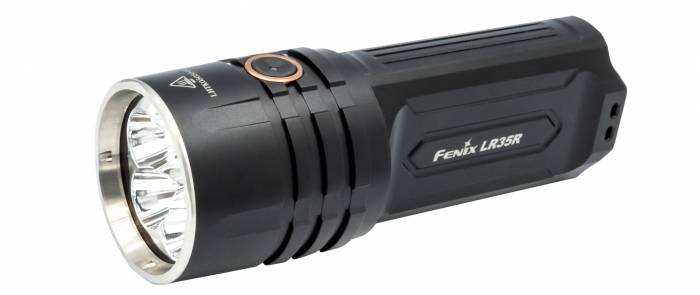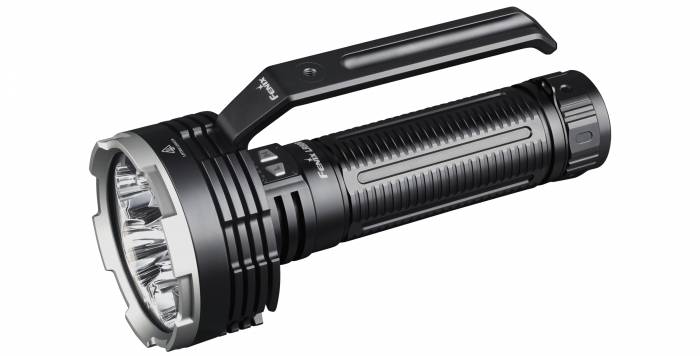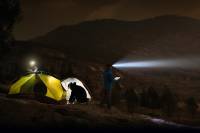Let There Be Light: Lumens Matter, but So Does Design
Shopping for an ultrabright flashlight or headlamp? Consider more than just the max lumens.
Selecting lumens, or brightness, is just the start. The distance and area of lighting are major factors to consider for outdoor use as well as other modes that provide greater versatility.
Below, we’ll run through some examples of Fenix’s brightest flashlights and brightest headlamps with a high output of lumens, yet designed for different functions.

Who Uses Big Lumens?
There are several reasons why you might want to light up your surroundings outdoors, from wayfinding to safety to sheer curiosity. We get it — sometimes you want the brightest flashlight or brightest headlamp that can go big and bold, just in case.
Think of lumens as the horsepower of the lighting world. It can put a light in a general class of power, but the devil is in the details. For hunting and military use, flashlights and lamps tend to start at 1,000-1,500 lumens and go up from there. Headlamps tend to range from 200 to 800 lumens; bike lights range from 100 to 1,000 lumens, but they’re usually in the 500-1,000 range.
We typically think of lights for hunting, camping, and hiking. However, search and rescue, signaling, self-defense, and other jobs that require seeing farther across vast lands and/or working at night, like ranching, are important use-cases for bright lights.
From a safety standpoint, a bright flashlight can be used for rescue signaling high into the air or from high ground. If a hunt extends into tracking downed game after dusk, more lumens can brighten up search areas for signs of game. Adding more light to a hike means seeing farther down the trail and can make you aware of animals you’d prefer not to see closer. If need be, a bright blast of light in their eyes can deter them.
Also, many of these headlamps and lights have modes that make them useful around the house for working in dark spaces (see the utility picks).
Distance & Area
A good garden hose nozzle will let you concentrate a stream or disperse the water in more of a spray, and sometimes even change the pressure. Sometimes, you may want a bit of both. This same principle carries over to the type of light you want from a high-output flashlight.
In this analogy, lumens can help you understand the brightness of a light by thinking of it as the overall measure of water emitted from the nozzle. But if you want to measure the intensity of a concentrated stream, there’s another measure in the lighting world: candela. Often reported as a light’s intensity, candela measures the amount of light in one direction.
Just as a nozzle controls water flow, the design of a flashlight’s lenses can concentrate its beam and create greater light in one spot. You can see that in the light’s reported max intensity numbers, measured in candelas.
As a real-world example, see how two different flashlights cast different intensities of the same output of lumens. On its High II setting, the Fenix LR50R shines 6,000 lumens up to 2,264 feet with max intensity of 118,400 candelas. Compare that to the 5.5-inch LR35R, which in turbo mode yields 10,000 lumens up to 1,640 feet and produces only 63,200 candelas.
They are close in performance, but it shows why you should consider whether you plan on spotlighting objects from far away — like football fields away — or floodlighting larger areas. Most Fenix lights do a bit of both.

What Else Can Your Light Do?
Once you find whatever you were looking for with a 3,000-lumen flashlight, don’t blind anyone with it. Be aware of how and where you aim your light. Granted, you can switch off to your handheld flashlight at close range, but consider a flashlight with something like a 400-lumen mode, too.
Having a rechargeable light is convenient and weighs less to ease the burden when carrying it long distances. Rechargeable lights are great for use in less-essential situations where other light sources are within reach or a short distance.
Otherwise, you want a light that has the option to kick into battery power so you’re not literally left in the dark. You have the option to carry a backup battery (or two) to swap into the light when duty calls.
And lastly, consider the size. Is this something that’s riding along in a truck or do you need it to be a backpack-friendly size and weight? These factors can play an important role in identifying what light is best for your needs.
Flashlights
These are some of the brightest flashlights that Fenix offers.
Fenix PD40R V2.0
The latest version of the rechargeable PD40R now throws up to 3,000 lumens with a long reach of 1,329 feet. To make it easier to use with gloved hands or when it’s wet, this handheld flashlight can switch between levels of brightness with a twist of its patented rotary switch. It is USB Type-C rechargeable and has a battery level indicator.
Fenix recommends for: Camp, trail, and utility.
Fenix LR35R
Big light, small package. This new 5.5-inch flashlight can produce 10,000 lumens. To power all that light, the LR35R uses two 21700 rechargeable li-ion batteries. It’s USB Type-C rechargeable and has a battery level indicator.
To keep that power from overheating during its max output, the flashlight has step-down protection. This balance of size and brightness is aimed at outdoor use for those who want to see across large landscapes or deep into the woods.
Brand note: This light requires a wall charger that is at least 2 amps for proper charging.
Fenix recommends for: Camp, utility, and specialty.
Fenix LR50R
The Fenix LR50R 12,000-lumen flashlight shines bright and far. At its max output, this flashlight throws a beam 3,117 feet. Eight lighting modes are powered by its li-ion battery pack or one to four 21700 li-ion batteries.
It can also charge other devices like your phone. For safety, it can detect when an object is too close and automatically lower the brightness to avoid overheating it.
Fenix recommends for: Search and rescue, utility, and specialty.
Fenix LR80R
At 18,000 max lumens, this is where Fenix flashlights top out. Beyond this, you may as well be hailing Batman.
The LR80R is pretty straightforward. There’s the max-output setting, which casts its beam 3,707 feet, and a low-output mode that can last up to 300 hours. Additionally, it has SOS and strobe settings.
The built-in battery charges in under 4 hours, and the flashlight can also be used as a power bank.
Fenix recommends for: Search and rescue, utility, and specialty.

Headlamps
These are some of the brightest headlamps Fenix offers.
Fenix HM65R-T
This versatile headlamp has a spotlight and floodlight that can be used together for 1,500 lumens of white and neutral light. The SPORT headband is a new fit system aimed at long-term comfort and is also used on the brand’s running headlamp.
Use the spotlight to guide you out on the trail. Or perhaps you need a floodlight across a rock wall for late descents, when the sun outpaced your climb. Both options translate to outdoor workspaces, too. The point is, this rechargeable headlamp can provide situational and hands-free lighting.
Fenix recommends for: Search and rescue, utility, and specialty.
Fenix HP25R V2.0
Fenix Lighting’s HP25R has a max of 1,600 lumens and a whopping 10 different light modes. The stay-put headlamp uses a dual-switch operation. It easily can toggle between the main 1,600-lumen spot and 400-lumen floodlight to own the night.
Other features with this high-powered headlamp include agile adjustment in three places, fast charging, and a red light feature for close-up tasks.
Fenix recommends for: Camp, trail, utility, and specialty.
Taming That Power
With big lumens comes big power. Fenix’s brightest flashlights can suck a lot of power, and the light they cast can get too hot for use up close. That’s why it’s important to consider some of the safety features of a big-power flashlight.
These lights don’t run like an ordinary everyday carry light, so things can get hot. Several of Fenix’s max-lumen flashlights use step-down overheating protection, which automatically reduces the power draw. Other models, like the LR50R and LR80R above, have a built-in proximity sensor to dim the brightness level when the head of the flashlight is too close to an object.
Additionally, flashlights with a battery level indicator can give you a heads-up on your power consumption. Other lights may have a lockout function that will keep the flashlight from turning on when packed away.
Consider how you will use a flashlight and which of these extra functions would serve you best.

This post is sponsored by Fenix. Check the brand’s website for more high-lumen flashlights and headlamps.
The post Let There Be Light: Lumens Matter, but So Does Design appeared first on GearJunkie.








